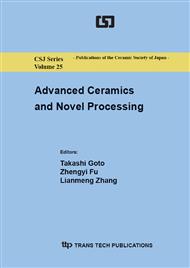[1]
The Ceramics Society of Japan Ed., Advanced Ceramic Technologies & Products, Springer, 2012.
Google Scholar
[2]
T.S. Suzuki, T. Uchikoshi, Y. Sakka, Control of Residual Stress in Multilayered Alumina Composites Preparerd Using EPD in a Strong Magnetic Field, Key Eng. Mater. 412 (2009) 233-236.
DOI: 10.4028/www.scientific.net/kem.412.233
Google Scholar
[3]
K. Yasuda, P. Lv, A Model for Stress History during Sintering of Ceramic Laminates, Mater. Sci. Forum 761 (2013) 73-77.
DOI: 10.4028/www.scientific.net/msf.761.73
Google Scholar
[4]
P. Lv, H. Yang, C. Gazeau, K. Yasuda, Estimation of Stress Generated during Co-sintering of Porous and Dense Alumina Layers, J. Ceram. Soc. Japan 121 (2013) 338-343.
DOI: 10.2109/jcersj2.121.338
Google Scholar
[5]
M. Niino, T. Hirai, R. Watanabe, Functionally Gradient Materials, J. Japanese Society of Composite Materials 13 (1987) 257-264.
Google Scholar
[6]
M. Niino, S. Maeda, Recent Development Status of Functionally Gradient Materials. I.S.I.J. Internatinal 30 (1990) 699-703.
DOI: 10.2355/isijinternational.30.699
Google Scholar
[7]
M. Koizumi, FGM Activities in Japan, Composites Part B 28B (1997) 1-4.
Google Scholar
[8]
T. Hirai, L. Chen, Recent and Prospective Development of Functionally Graded Materials in Japan, Mater. Sci. Forum 308-311 (1999) 509-514.
DOI: 10.4028/www.scientific.net/msf.308-311.509
Google Scholar
[9]
N. Noda, Thermal Stresses in Materials with Temperature-dependent Properties, Appl. Mech. Rev. 44 (1991) 383-397.
Google Scholar
[10]
Y. Tanigawa, Theoretical Approach of Optimum Design for a Plate of Functionally Gradient Materials under Thermal Loading, Thermal Shock and Thermal Fatigue Behavior of Advanced Ceramics, NATO ASI Series E 241 (1992) 171-180.
DOI: 10.1007/978-94-015-8200-1_14
Google Scholar
[11]
Y. Fukui, Y. Yamanaka, K. Wakashima, The Stress and Strains in a Thick-walled Tube of Functionally Graded Materials under Uniform Thermal Loading, International Journal of Japan Society of Mechanical Engineers Series A 36 (1993) 156-162.
DOI: 10.1299/jsmea1993.36.2_156
Google Scholar
[12]
T. Fuchiyama, N. Noda, T. Tsuji, Y. Obata, Analysis of Thermal Stress and Stress Intensity Factor of Functionally Gradient Materials, Ceramic Transactions: Functionally Gradient Materials, 34(1993) 425-432.
Google Scholar
[13]
Y. Tanigawa, Some Basic Thermoelastic Problems for Nonhomogeneous Structural Materials, Appl. Mech. Rev. 48 (1995) 377-389.
Google Scholar
[14]
J.N. Reddy, Analysis of Functionally Graded Plates, Int. J. Numer. Meth. Eng. 47 (2000) 663-684.
DOI: 10.1002/(sici)1097-0207(20000110/30)47:1/3<663::aid-nme787>3.0.co;2-8
Google Scholar


